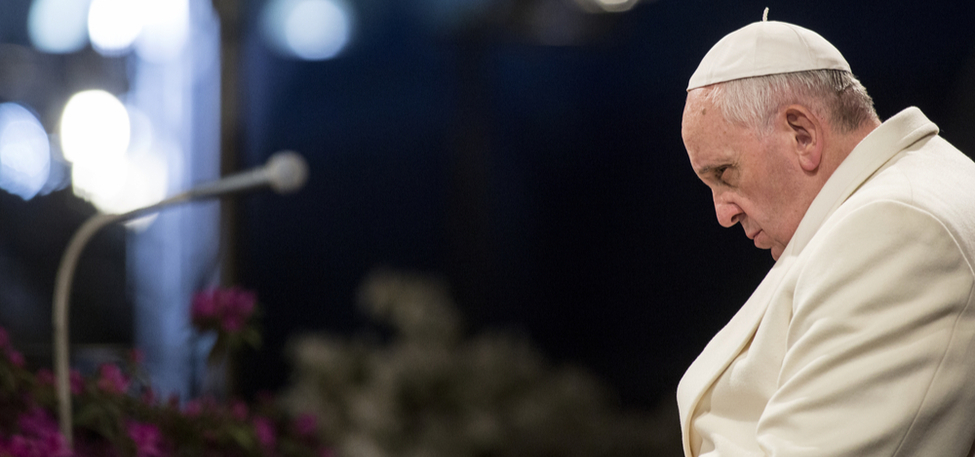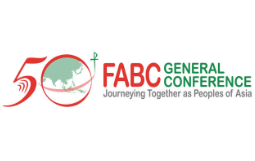A new imagination of the possible: Seven Images from Francis for post-COVID-19
The first global pandemic of the digital age arrived suddenly. The world was stopped in its tracks by an unnatural suspension of activity that interrupted business and pleasure.
Jul 25, 2020

By Antonio Spadaro, SJ
The first global pandemic of the digital age arrived suddenly. The world was stopped in its tracks by an unnatural suspension of activity that interrupted business and pleasure.
“For weeks now it has been evening. Thick darkness has gathered over our squares, our streets and our cities; it has taken over our lives, filling everything with a deafening silence and a distressing void that stops everything as it passes by. We feel it in the air, we notice in people’s gestures, their glances give them away. We find ourselves afraid and lost.”
These are the words Pope Francis used to portray the unprecedented situation. He pronounced them on March 27 before a completely empty Saint Peter’s Square, during an evening of Eucharistic adoration and an Urbi et Orbi blessing that was accompanied only by the sound of church bells mixed with ambulance sirens: the sacred and the pain.
The Pope has also stated that the crisis period caused by the COVID-19 pandemic is “ a propitious time to find the courage for a new imagination of the possible, with the realism that only the Gospel can offer us.”
The thick darkness, then, allows us to find the courage to imagine. How was it possible to send out such a message in a moment of depression and fear? We are accustomed to the probable, to what our minds suppose should happen, statistically speaking. However, we often lack the vision of the possible, which is sometimes con fined to the world of the imagination. We are not accustomed to dwelling in possibility, to use the words of Emily Dickinson. So we need a “realism” that breaks our “fixed or failing patterns, modes and structures” and inspires us to imagine a different world, “making all things new,” as the Book of Revelation says. “Are we willing to change our lifestyles?” the Pope asks.
1. Francis and contagion in a slowed down world
It is clear that there is a compelling need to understand what is happening to us, to give a human and spiritual reading of what we are living. For Francis, “understanding what God is saying to us at this time of pandemic also represents a challenge for the Church’s mission.” It is also clear that we must first of all understand what we have done wrong. The pope, as a truly global leader, the only one at the moment recognised as such even in unsuspected quarters, has spoken of a seriously ill planet, of planetary injustices caused by an economy that aims only at profit, of international conflicts that today must be brought to an immediate end, and of embargoes and national selfishness. The pandemic has unmasked our vulnerability and the false and unnecessary security with which we have built our agendas, our projects, our habits and our priorities.
Change will occur if there is a chemical reaction between the “overflowing proclamation” of the Gospel and life “as it comes.” This is what generates the “renewing outlook” that we need today. We are not called “to restart” in order to return to the normality of a golden age that in reality never was golden, but instead “to start anew.” The narratives of the restart are harmful, because they naturally tend to restore balances that must change. We need a new beginning.
The coronavirus is, in its own way, an alien. Or rather, by invading our bodies, it suddenly has changed the way we look at things; it forced us to see with an unaccustomed perspective, and we saw the world turned upside down. From that empty St Peter’s Square on March 27, Francis spoke of a “necessary immunity.” But this is because the virus has become a metaphor that reveals a “sick world.” Immunity to the virus becomes the image of the necessary immunity to the evil of the world. Even the pandemic can be metaphorically overturned in its own destructive meaning and understood as a “contagion of hope.”
With COVID-19 we saw ourselves projected into a mirror that suddenly opened up before us. We saw our image inverted but, at the same time, connected to all the space around it: the deserted megalopolises, the absence of traffic, the cities as appendages of empty fields.
The effect has been like that of a spinning pinwheel or a cursor, which appears on our monitors when there are slowdowns in programmes or computer connections. We do not tolerate slowness or waiting, and so we normally abandon the blocked programme or the slow connection. Now the “spinning wheel” caused by the virus is prolonged, and the state of suspension has affected society, the sense of relationships, worship and trade, the value of presence. This is why the infection has given us a sense of the apocalypse. Due to this shock, the inability to imagine a benign future has emerged.
During this time of pandemic, Francis has intervened many times. Above all, he has comforted millions of people – from Rome to Beijing, from Beirut to Lima – with the Masses celebrated in Santa Marta. There has been the whispering of the Gospel in the silence of our homes, blessing with the Eucharist, mourning of death and suffering, the celebrating of life as much as possible. Consolation, comfort and prayer of intercession entered the homes of so many people. This is the first message of an accompanying Church. But Francis also aimed very much at building a new imagination to interpret both the present moment and the future, the vision of the possible.
We now look at the seven figures he has used to articulate his argument. They are the boat, the flame, the underground, the war (of the poets), the anointing, the window, and the pandemic itself understood as a metaphor.
2. The boat in the storm
The first image is the boat. In St Peter’s Square that March 27, at 6.00pm, before adoring the Blessed Sacrament and giving his blessing Urbi et Orbi, the Pope said: “We have realised that we are in the same boat, all of us fragile and disoriented, but at the same time important and needed, all of us called to row together, each of us in need of comforting the other. We are all of us in this boat.”
The powerful image was articulated in his language and contextualised. The boat is in the storm, which “unmasks our vulnerability and leaves uncovered those false and unnecessary certainties with which we have built our agendas, our projects, our habits and priorities.” This is what the pandemic is: a storm that reveals the condition of the present in which we all live, a mirror that mercilessly reflects the image of a present in which “we have not awakened to wars and planetary injustice, we have not listened to the cry of the poor, and of our seriously ill planet. We continued undaunted, thinking that we would always remain healthy in a sick world. Now, while we are at sea in turmoil, we implore you, ‘Wake up Lord!’” Similarly, in one of his homilies, Francis also used the image of the flood.
Looking into this mirror, the invocation, the prayer, is formed. Reality makes prayer spring from the heart, not pious speech. It also prompts action, for “it is time to reset the course of life toward You, Lord, and toward others.” Sailing in this boat, we can “look at so many exemplary companions who, in fear, reacted by giving their lives.”
And who are these comrades? Francis does not intend to make abstract speeches. He lists them, because a list is always the mark of reality in its richness and diversity: “doctors, nurses, supermarket employees, cleaners, caregivers, providers of transport, law and order forces, volunteers, priests, religious men and women and so very many others who have understood that no one reaches salvation by themselves.”
The boat becomes the figure of a radical and human fraternity that the virus has made clear by attacking anyone and everyone, without any distinction of race, religion, origin or nationality. This is what the boat indicates: fraternity.
Those words used by the pope in addressing the Jesuits in his homily on September 27, 2014, now apply to the whole of humanity. And the storm is the ideal place to discover fraternity, because it is not the situation to display or boast about strength and security. The storm implies embracing – with long oar strokes – “all the adversities of the present time, abandoning for a moment our yearning for omnipotence and possession,” and finding the courage to open “spaces where everyone can feel called and allow new forms of hospitality, fraternity and solidarity.” The believer recognizes that this fraternity is not human work and that one must “give space to the creativity that only the Spirit is capable of arousing."
3. The new flame in the night
It was in the Easter Urbi et Orbi blessing that Francis provided another image, that of the flame, the second figure providing a stimulus to envisage what might be possible. If the pandemic was previously “storm,” now it is “night,” “the night of a world already struggling with epochal challenges and now oppressed by the pandemic, which puts our great human family to the test.” And precisely during this night “the voice of the Church has resounded: ‘Christ, my hope, is risen!’”
Francis often uses the image of the night. In particular, at the beginning of his pontificate, in Brazil, when referring to the disciples walking to Emmaus he said: “We need a Church unafraid of going forth into the night.” And on April 26 – in the midst of the pandemic – during the Regina Coeli he said: “We will discover that there are no unexpected events, no uphill paths, no nights that cannot be faced with Jesus.”
Francis describes the night of this pandemic time by focusing on four precise aspects, in some way four “nights.” These nights compose a picture of the situation, starting from the concerns of the ordinary citizens to open up a wider look at Europe, and the more complex international scenario, caught up between sanctions and conflicts. This list of “nights” should be carefully reviewed.
The first night touches the life of the citizens, who live in “a time of concern for the uncertain future, for the work they risk losing and for the other consequences that the current crisis brings with it.” The pope encourages “those with political responsibilities to work actively for the common good of citizens, providing the necessary means and instruments to enable everyone to lead a dignified life and to encourage, when circumstances permit, the resumption of the usual daily activities.”
The second night is international sanctions. Francis launched an appeal for the easing of the sanctions “which inhibit the possibility of the countries that are the recipients of them to provide adequate support to their citizens, and enabling all states to meet the greater needs of the moment, reducing, if not even forgiving, the debt that weighs on the budgets of the poorest ones.”
The third night is selfishness and rivalry between states. Here the Pope’s speech was centred on Europe, to which he dedicated various references, including during the Masses celebrated in Santa Marta. At Easter he said: “Among the many areas of the world affected by the coronavirus, I address a special thought to Europe. After the Second World War, this continent was able to rise again thanks to a concrete spirit of solidarity that allowed it to overcome the rivalries of the past. It is all the more urgent, especially in today’s circumstances, that these rivalries should not be revived, but that everyone should recognise themselves as part of one family and support each other. Today the European Union faces an epoch-making challenge on which not only its future but that of the whole world will depend. Do not miss the opportunity to give further proof of solidarity, even by resorting to innovative solutions. The alternative is only the selfishness of particular interests and the temptation to return to the past, with the risk of putting peaceful coexistence and the development of future generations to the test.”
The fourth night is the night of armed conflict, with the call for a “global and immediate ceasefire in all corners of the world. This is not the time to continue manufacturing and trafficking weapons, spending huge amounts of capital that should be used to heal people and save lives.” Here the direct references were to Syria, Iraq, Lebanon, Israel and Palestine, Ukraine, several African countries and Mozambique in particular, Libya, Greece and Turkey, Venezuela. The four nights of the pandemic are a wide-ranging look at the world at the time of COVID-19 that identifies the knots to be undone. On to this scenario of “nights” of the world falls the prayer: “Christ our peace, enlighten those who have responsibilities.” This is an appeal that reveals the vanity of the reasoning of those who do not want to understand how the pope’s words about the world are not inspired by politics or ideology, but by the Gospel of Christ.
It is clear that Francis also intends to develop the principle of moral leadership proper to Vatican diplomacy, in a world that sees its geopolitical balances upset and that needs a robust confirmation of democratic dynamics. ––La Civilta Cattolica
––Continued next week







Total Comments:0